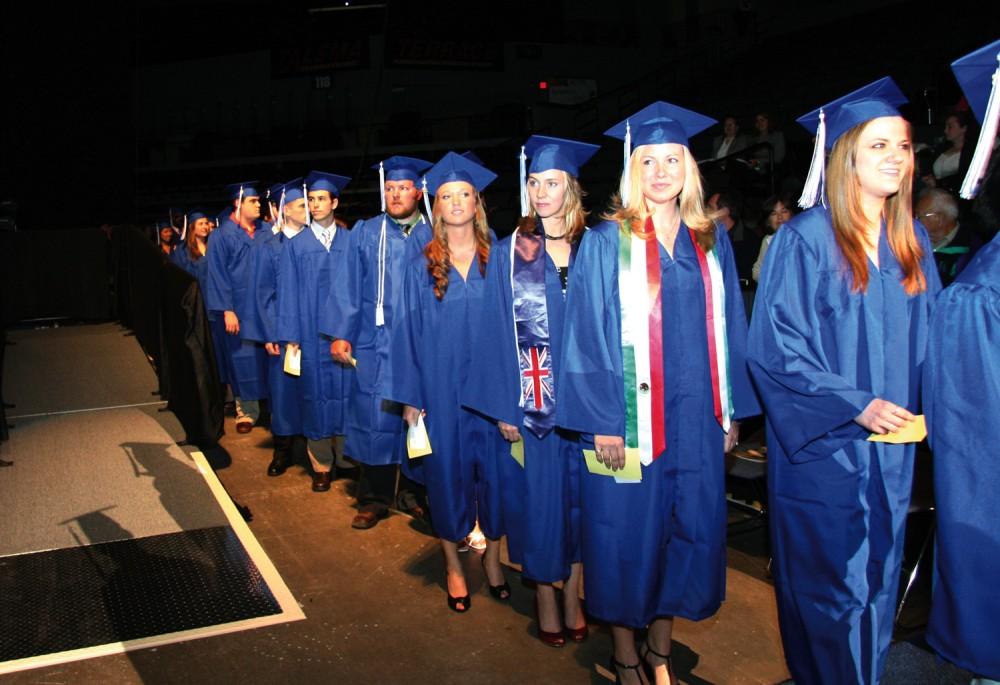University’s graduation rates improve

GVL Archive/ Pete Tabberer Walking towards accomplishment: A group of GVSU graduates wait in line to walk across the stage and recieve their diplomas at the May 2008 Commencement.
Apr 12, 2010
Graduation rates at Grand Valley State University have reached a record high, with six-year graduation rates climbing to almost 61 percent. Four-year rates stayed steady at 26 percent.
These figures put GVSU above the national six-year average, 56.1 percent, as well as the Michigan six-year average, about 51 percent, according to the National Center for Higher Education Management Systems.
Graduation rates are based on students who start at GVSU without having been enrolled at another institution after high school, said Philip Batty, director of Institutional Analysis. However, this does not always paint an accurate picture of the number of students who graduate college, he said.
“It’s hard to know how many people are excluded,” he said. “Once students leave here, we have relatively little information about them and how they perform elsewhere or if they go elsewhere.”
In fall 2009, almost 30 percent of new students admitted to GVSU transferred from another institution.
The difference between four-year and six-year graduation rates has also caused concern for educators. Dean of Students Bart Merkle said there are several reasons for the gap, including block scheduling.
“The truth is, there’s a lot of students who take 12 credits because it gets them to full-time enrollment for financial aid and then they end up falling behind,” he said, adding the university now tries to encourage students to take 15 or 16 credits per semester.
Merkle also added that some of GVSU’s most popular majors, including education, are almost impossible to complete in four years. Data about the average time it takes a GVSU student to complete their degree was not available.
“The reason we don’t have it at hand and use it more often is because it assumes you have a population of graduates,” Batty said. “It hides the existence of that problem of people who don’t graduate, and we don’t want to ignore that problem.”
Brian Bossick, a career outreach specialist with the Counseling Center, said he believes students are under stress to graduate on time.
“I think with the state of the economy, students are feeling a lot of pressure to get in and get out as quickly as possible,” he said. “Especially if students change their major or fail classes or encounter challenges, we go through situations where things could add a couple of years and that creates anxiety.”
Merkle said he believes the increased time and money some students require to graduate can be difficult.
“I’m sure it’s both discouraging and frustrating,” he said. “We’re trying to do everything we can to let students know what they need to do to graduate on time.”
Those initiatives include MAP-Works, a survey given to freshmen this year to help them understand their study habits and provide an early alert to the administration if a student might have problems.
MyPath added to MyBanner
Merkle said the administration is also introducing a new program through MyBanner for next year, MyPath. Similar to the degree evaluation feature in MyBanner, MyPath will allow students to look at the classes they need to complete for their degree as well as general education requirements. The program would also let students look at which requirements their classes would satisfy if they changed majors.
Despite the challenges students face, the university is optimistic about student performance. In December, GVSU announced it had increased the number of graduates since 1999 by a greater amount than any other public university in Michigan. The total degrees awarded between 1999 and 2009 increased by almost 92 percent.
“We are doing our part to ensure that the state of Michigan has the well-educated college graduates it needs for the knowledge of the 21st century and keeping them here,” said President Thomas J. Haas, in a press release.
However, Michigan educators are still concerned about the total number of graduates in the state. In 2004, Gov. Jennifer Granholm announced plans to double the number of college graduates by 2014, but according to a study done by the Detroit Free Press, the number of graduates only increased 4.4 percent during the first four years of the initiative.
According to a memo sent to the Michigan House Appropriations Subcommittee on Higher Education, the range of graduation rates at Michigan public universities is significant. Four-year rates in 2006 ranged from 6.6 percent to 67.2 percent while rates increased to 31.7 percent to 86.6 percent at the six-year level.
Admissions selectivity, the median ACT score of the freshman class, the percentage of students receiving Pell grants and the school’s status as a historically black university can all affect graduation rates, the memo read.
GVSU continues to try to make graduation an attainable goal for students, Merkle said. Among other things, the administration is attempting to eliminate prerequisite courses when possible.
“Programs that are heavy in prerequisites can really make graduation a challenge, especially if that student selected a major a little bit late or if they changed majors at some point,” Bossick said.
Merkle said although GVSU is working to make graduation attainable, it ultimately boils down to the students.
“I think we have good faculty and staff who care about our students,” he said. “But in the end, students are the ones who have to take the courses and do the work, and that doesn’t change.”























